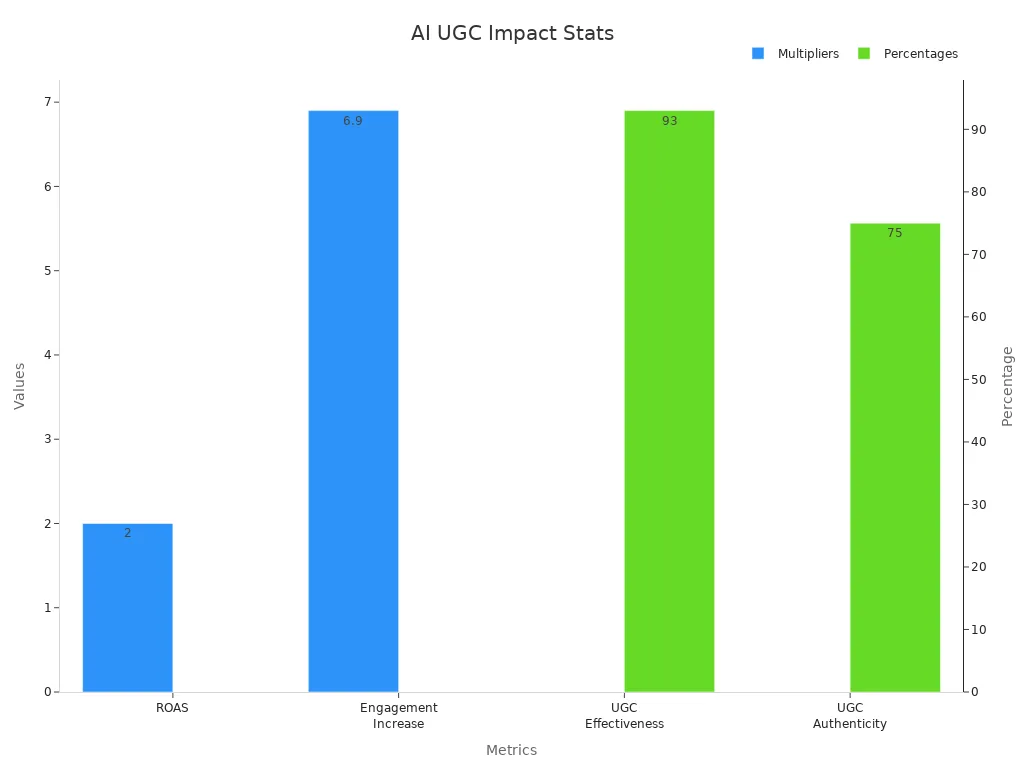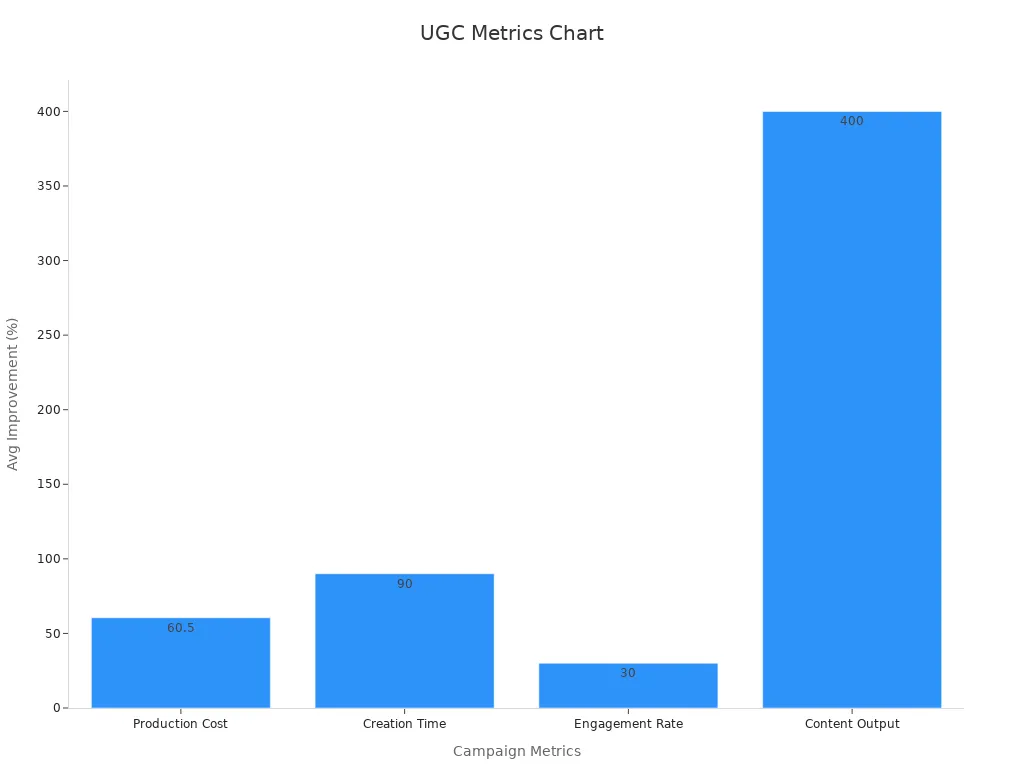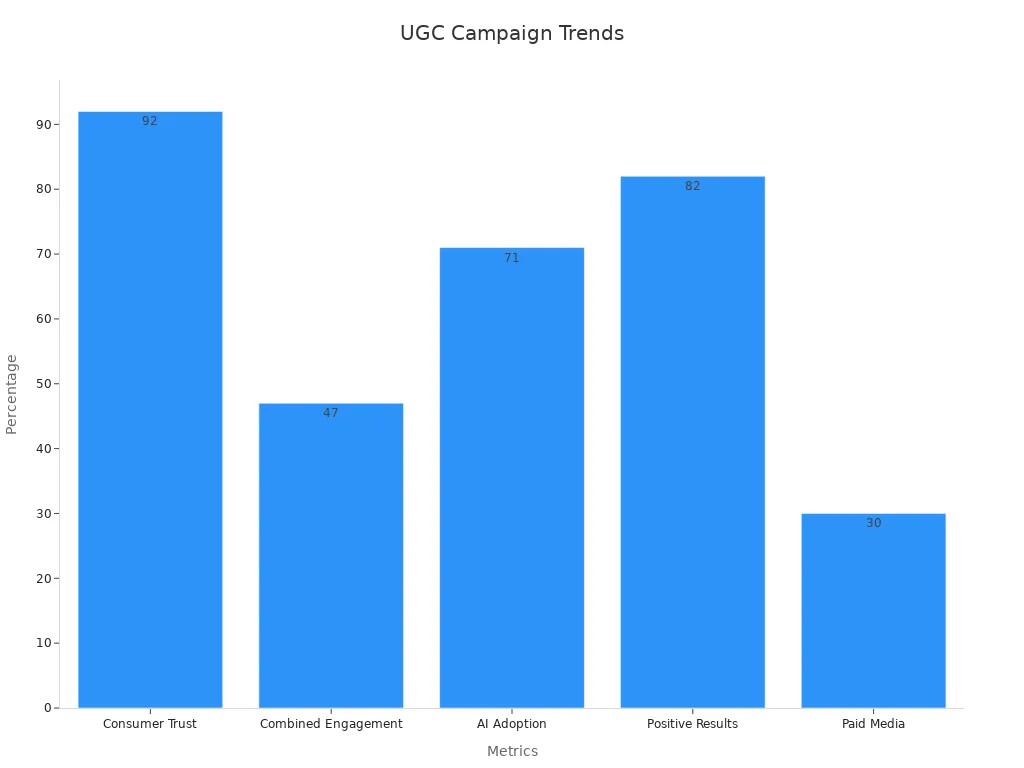Scaling UGC Campaigns with AI Content Curation

AI content curation is revolutionizing how brands approach scaling UGC campaigns. It enables brands to work faster while maintaining authenticity. For example, Teddy Blake doubled their return on advertising spend (ROAS) by using AI to identify creators and select the best content. Posts featuring user-generated content receive nearly seven times more likes and comments compared to brand-created posts.
Metric / Statistic | Value / Description |
|---|---|
Return on Advertising Spend (ROAS) | Teddy Blake achieved 2x ROAS by leveraging AI to find creators and curate content |
Engagement Increase | Posts with UGC see 6.9 times more engagement than posts made by brands |
Marketers acknowledging UGC effectiveness | 93% of marketers agree that UGC outperforms traditional branded content |
Marketers recognizing UGC authenticity | 75% of marketers believe UGC makes branded content feel more genuine |
Samsung's AI application | Samsung applied AI to discover top UGC, enhance social ads, and optimize campaign insights |

While AI greatly aids in scaling UGC campaigns by handling large volumes of posts, human oversight remains essential to ensure quality and compliance with guidelines.
Key Takeaways
AI lets brands find, check, and share user content quickly and at a lower cost. This makes campaigns work better.
Using AI for moderation and curation keeps content safe, real, and matches the brand. It also saves time for creative tasks.
AI makes content fit different groups of people. This helps get more likes, clicks, and sales.
People still need to watch over AI. They can spot mistakes, keep quality high, and help people trust the brand.
Picking the best AI tools and having clear goals helps brands run good UGC campaigns. This also helps them follow rules and connect with people.
Scaling UGC Campaigns with AI

Artificial intelligence has changed how brands grow UGC campaigns. AI helps by doing moderation, curation, and personalization. This lets brands handle thousands of user posts very fast. Brands can gather, check, and share content much quicker than before. Manual work is slower and cannot keep up. Now, marketers can spend more time on ideas and planning. AI takes care of boring, repeated jobs.
Benefits of AI for UGC
AI gives many good things to UGC campaigns. These help brands work faster, stay real, and see real results.
AI makes it easier to collect and approve content. Campaigns can start sooner.
AI picks the best content by looking at what people like most.
It works with CRM and marketing tools to help manage and target content.
AI does a lot of the checking and rights work, so people have more time for creative jobs.
Generative AI can make content that feels real and matches the brand’s voice.
AI changes content for different places and platforms, so it always fits.
Brands like Coca-Cola and Airbnb use AI to make UGC feel special and fun. These brands see more likes, better ad results, and faster content creation.
Metric | Traditional Approach | AI-Powered UGC Result | Improvement / Benefit Description |
|---|---|---|---|
Cost per Click (CPC) | Baseline | Big savings on ads | |
Cost per Result (CPR) | Baseline | Reduced by 28% | Cheaper to reach goals |
Production Time | Days to weeks | Minutes | Content made much faster |
Cost per Image (Fashion Nova) | Several thousand dollars | About $108 (£85) | Content costs much less |
Production Time (Fashion Nova) | 2–3 months | 1 week | Takes half the time |
Booking Conversion (Airbnb) | Baseline | Up to +4.75% increase | More bookings with AI UGC |
Click-Through Rate (CTR) | Baseline | 4x higher | More people click and ads work better |
CPC (AI-driven UGC) | Baseline | 50% lower | Ads cost less |
AR/VR Engagement | Baseline | 3x more user engagement | People enjoy AR/VR more and buy more |
AI also brings clear improvements:
Making content costs 44-77% less.
Creating content is 85-95% faster.
Engagement goes up by 25-35%.
Brands make 400% more content each week.

These numbers show why top brands use AI to scale UGC campaigns.
Key Challenges
Even with these good things, brands still face problems with AI UGC campaigns.
It is hard to control quality and creativity. UGC creators are not always experts. Content may not always match the brand.
Moderation is risky. There can be wrong or bad content, or legal problems. AI must check content well to keep the brand safe.
It is tough to track and measure results. Brands often use likes and comments, but that does not tell the whole story.
Keeping the brand the same and being honest is still hard. AI needs human help to follow rules.
70% of brands think AI influencer marketing gives better ROI, but many still find it hard to measure success.
Mesha’s AI adds small changes and mistakes to look like real users. This keeps things real, but brands still need to check for quality and rules.
To scale UGC campaigns with AI, brands need to use both AI and people. This keeps content real, safe, and useful.
AI Moderation and Curation

Automated Moderation
AI moderation tools help brands handle lots of user posts fast. These tools check posts, pictures, and videos for rule breaks. They remove things that do not match brand guidelines. For example, Cloudinary’s AI finds bad or off-brand content before it is posted. This early check keeps campaigns safe and saves time for teams.
Many companies use AI to find harmful or unwanted posts. Facebook’s RoBERT system finds almost 95% of hate speech and removes it before people see it. Microsoft’s PhotoDNA matches digital fingerprints to block illegal images. Social media sites share databases to stop terrorist content from spreading. AI deals with easy cases like spam or clear rule breaks. Human moderators look at harder posts. This teamwork keeps content safe and makes less work for people.
Automated moderation helps protect a brand’s reputation and speeds up reviews. Brands can start campaigns faster and keep their communities safe.
Intelligent Curation
AI does more than just block bad posts. It also helps brands find the best user posts to share. Machine learning sorts and ranks UGC by quality, fit, and engagement. For example, Airbnb uses AI to show reviews that travelers want to see. AI checks likes, comments, and shares to pick the best content for each channel.
AI curation tools also find trends and patterns in user posts. They look at data to learn what customers like and how they feel about products. Brands use these insights to change campaigns and connect better with people. By using AI for both moderation and curation, brands keep UGC campaigns fast, on-brand, and strong.
Personalization and Consistency
Personalized Content
AI-driven UGC campaigns now make content feel special for each person. Brands use AI to look at pictures, words, and how people act online. This helps brands show the right content to the right people. AI tools watch likes, clicks, and sales as they happen. These numbers help brands know what works best for each group.
AI picks the best UGC by checking pictures and feelings.
Dynamic creative optimization changes ads for age, place, or actions.
AI changes headlines, captions, and calls-to-action to match what users want.
Brands change content for people in different countries, so it feels personal.
Showing UGC ads again to people makes them trust the brand more.
AI tools give feedback all the time, so campaigns stay new and work well.
Many brands get good results from these ideas. The table below shows how AI-personalized UGC helps:
Brand/Source | Campaign/Statistic Description | Impact Metric |
|---|---|---|
Epsilon | Personalized marketing using AI | |
Coca-Cola | AI-generated UGC-like social media content | 30% increase in engagement |
Adidas | AI-personalized product recommendations in UGC style | 40% boost in conversion rates |
General UGC | UGC ads vs traditional ads | 4x higher click-through rates, 50% lower cost-per-click |
AI-powered personalization helps brands connect with people and get more likes and sales.
Brand Consistency
Keeping the same brand voice helps people trust and like a brand. AI helps brands keep their message the same everywhere. It checks for mistakes and helps follow the rules. Experts say brands should be honest about using AI. Brands that tell people about AI and use real people too get more trust.
Trust Factor | Customer Loyalty (%) |
|---|---|
Consistent Branding | 67 |
Reliable Products | 67 |
Transparent Communication | 67 |
A survey shows 67% of people stay loyal to brands they trust. Most people want the same brand feeling everywhere. AI helps by keeping track of brand stuff and checking for problems often. Brands that use both AI and people make real and honest campaigns. This helps brands build strong relationships and keep their message clear.
Steps to Implement AI in UGC Campaigns
There are three main steps to use AI in UGC campaigns. First, brands set clear goals. Next, they pick the best tools. Last, they make content that gets good results. Each step helps make the campaign work well, follow rules, and keep people interested.
Goal Setting
Brands begin by choosing what they want to do. They may want more likes, more sales, or better brand feelings. They pick numbers to measure things like reach, views, likes, and money made. These numbers help brands see if they are doing well. Brands use AI to help change their goals as they learn more. Marketers look at their own data and compare it to others. This helps them set goals that make sense. They also change their numbers if AI finds new problems or trends.
Tip: Brands should always tell people when content is made by AI. Most people, about 94%, want to know if AI was used.
Tool Selection
Picking the right AI tools is very important. Brands want tools that can check posts, tag content, and show results fast. Some popular tools are OpenAI’s GPT-3, Jasper, and Copysmith. Each tool is good at different things like speed, choices, or price. For example, Mesha’s tool checks for rule breaks and adds labels right away. This helps brands follow the law and build trust.
Tool Feature | Benefit |
|---|---|
Automated Moderation | Keeps content safe and on-brand |
Sentiment Analysis | Targets content to the right audience |
Real-Time Analytics | Tracks campaign performance |
Note: Using both AI and people helps make sure content is good and real.
Content Generation
After picking goals and tools, brands start making and sharing posts. AI helps gather UGC from many places, remove bad posts, and make posts fit each group. Brands like Sephora and Airbnb use AI to pick the best posts and make them special. This means more likes and faster updates. For example, a Shopify beauty store made four times more posts each week and spent 65% less money after using AI.
Let AI check and tag posts.
Make posts fit each platform and group.
By doing these steps, brands can grow UGC campaigns, follow rules, and get good results everywhere.
Tools and Platforms
Recommended Solutions
Brands can pick from many AI-powered UGC tools. Each tool has special features to help campaigns grow and work better. Some tools help brands get more likes and comments. The table below shows some top choices:
Platform | Starting Price | Key Strengths | Limitations |
|---|---|---|---|
MagicUGC | $249/month (Turbo) | AI script optimization, unlimited videos, multi-avatar options, Brand DNA Scanner | Higher cost for smaller businesses |
JoinBrands | Contact Sales | Micro-influencer partnerships, authentic social proof, strong integration | Focused mainly on contests |
Creatify | Contact Sales | AI avatars, scriptwriting tools | Limited customization |
Arcads | Contact Sales | Text-to-video conversion, AI actors | Basic analytics |
Yotpo | $15/month | E-commerce integration | Advanced tools require premium plans |
MagicUGC can make thousands of videos very fast. This saves a lot of money, up to 90% less than old ways. People using it see more sales and much more engagement. JoinBrands helps brands work with real micro-influencers. Yotpo and Bazaarvoice are good for online stores. Prices are different, so brands can pick what fits their money and needs.
AI-powered UGC tools also have other helpful features. They can write scripts, support many languages, and show results right away. These tools help brands make content fast, try new ideas, and reach people all over the world. Reviews from trusted sites say these tools make content better and help brands grow.
Integration Tips
Brands need a good plan to use AI tools in UGC campaigns. First, they should know what they want, like more likes or faster posts. Then, they pick tools that fit these goals and work well with what they already use.
Use Sprout Social or Hootsuite to manage and check UGC on different sites.
Let tools like Copy.ai or Claude AI collect and check posts automatically.
Connect AI tools to online stores for easy product tags and reviews.
Turn on real-time analytics to see how campaigns are doing and change plans fast.
Tip: Brands can let AI make videos, change posts for different groups, and save up to 80% of time. This lets teams spend more time on creative ideas while AI does the boring work.
Experts say brands should use both AI and people together. This keeps content real and matches the brand’s style. By doing these things, brands get the most from AI UGC tools and run better campaigns.
Compliance and Brand Safety
Data Privacy
Brands need to keep user data safe during AI-driven UGC campaigns. Data privacy laws and copyright rules tell brands what they can and cannot do with content. If companies use content without the right permissions, they can get into legal trouble. Some court cases, like Feist Publications Inc v. Rural Telephone Service Company Inc and Authors Guild v Google, Inc, show why following these rules is important. These cases prove that strong data privacy is needed when using AI.
People really care about how brands use their data. Surveys say 80% of people worry that AI could be used for cyber attacks. Also, 78% are afraid of identity theft. Most people want brands to be honest about how they use AI and to follow strict rules. In fact, 85% of people want the government to make AI safe and secure. Brands that are open and follow privacy laws earn more trust from customers.
Companies should always ask before using someone’s content. They should also tell people how AI uses and keeps their data. This helps keep campaigns safe and builds trust for a long time.
Quality Control
Quality control makes sure UGC campaigns match the brand and work well. AI tools check posts for bad words, wrong pictures, or fake stuff. These tools can find problems before posts go live. Brands use things like engagement rates, conversion rates, and customer satisfaction to measure quality.
Benchmark Category | Metrics / Methods |
|---|---|
Engagement Metrics | Likes, Comments, Shares, Interaction Rates |
Conversion Metrics | Click-through Actions, Sales, Conversion Rate |
Customer Satisfaction | CSAT Scores, Surveys, Feedback |
ROI | Return on Investment, Cost vs Revenue |
Quality Control | AI moderation, Brand consistency, Content guidelines |
Performance Monitoring | Real-time CTR, ROAS, Automated alerts |
AI-powered compliance steps, like those from MarketBeam, use checks and approvals to lower risks and speed up content approval. For example, a biotech company started a campaign 40% faster and had no audit problems by using AI to spot bad language. Fintech brands have passed audits and cut approval times in half with AI risk scoring. These steps help brands post content quickly and keep it safe and trusted.
Training people often and using AI tools together helps brands follow the rules and stay safe. This way, brands avoid mistakes and keep campaigns working well.
Overcoming Pitfalls
Avoiding Over-Automation
Brands use AI to handle lots of user-generated content. But using too much automation can cause problems. Sometimes, automated systems do not understand important details or culture. This can make mistakes that hurt users and brands.
Automated classifiers sometimes remove helpful breast cancer posts on Instagram. These systems did not see the medical meaning, even with clear text.
After new updates, 2,500 more posts needed people to check them in 30 days. This means automation took down too many posts before.
Meta’s Media Matching Service once took down a political cartoon. Later, 98% of appeals worked, showing most removals were wrong.
Automated penalty systems can turn off accounts very fast. Journalists and activists have lost their accounts because of quick AI choices.
AI moderation tools have trouble with different cultures and languages. This can make rules unfair, especially for rare languages.
Relying too much on automation can hurt free speech. Automation works best when people help check for mistakes.
Brands should use AI to work faster but always let people check for errors and protect user rights.
Human Oversight
People are still very important in UGC campaigns. Humans add understanding, kindness, and fairness that AI cannot give. Clear review steps help balance user rights and platform rules. Human moderators check claims, handle appeals, and make fair choices. This helps build trust and follow the law.
A good content curation plan often uses these steps:
If content is risky or unclear, people review it.
Human moderators decide what happens to flagged posts.
Their choices help AI get better over time.
This teamwork uses AI’s speed and human judgment together. Brands get better results, safer campaigns, and more trust from users.
Best Practices
Collaboration
Brands get the best results when AI and creative teams work together. AI can sort user-generated content fast by looking at pictures and feelings. Creative teams pick the most interesting posts and change them for each campaign. This teamwork keeps the brand’s message clear and the content new.
AI helps make ads fit different groups. Creative teams use this to test many ad versions at once.
AI finds posts that do not match the brand or are not okay. Teams can focus on ideas while AI checks for problems.
Brands use AI to change UGC for social media, email, ads, and websites. This makes the message the same everywhere.
AI gives real-time numbers to show what works. Teams can quickly change plans to get better results.
When brands mix automation and creativity, they get more people interested and better results. Brands let real customer voices shine while keeping campaigns fast and matching the brand.
Measuring Success
Brands need clear ways to see how well AI UGC campaigns work. They should use numbers and check quality to understand everything. The table below shows important ways to measure and tools to use:
Metric Type | Examples of Metrics | Purpose / Insights Provided | Recommended Tools / Data Sources |
|---|---|---|---|
Quantitative Metrics | Reach, Impressions, Likes, Comments, Shares, Mentions, Conversion Rates, Click-Through Rates (CTR), Customer Lifetime Value (CLV) | Measure audience size, engagement, conversion effectiveness, and ROI | Social media analytics (Facebook Insights, Twitter Analytics), Google Analytics, CRM systems (Salesforce, HubSpot) |
Qualitative Metrics | Sentiment Analysis, Content Quality Assessment | Understand audience emotional response, content relevance, and brand alignment | Sentiment analysis tools (Brandwatch, Mentionlytics), NLP algorithms |
Tracking & Analytics | Custom Tracking Parameters | Attribute conversions and engagement to specific UGC content sources | Google Analytics, UGC platform analytics (EnTribe, TINT) |
Brands should test and change campaigns often. Using both AI data and human checks helps brands stay focused and reach their goals.
AI helps brands make UGC campaigns fast and cheap, but people still need to check the work. This keeps trust and makes sure things feel real. The table below shows why using both AI and people is best:
Metric | AI UGC | Human Influencers |
|---|---|---|
Cost | $5–$10 per minute | $100–$50,000+ per post |
Engagement | Lower | 266% higher |
Scalability | Unlimited | Limited by human capacity |
Trust | 36.7% authenticity concern | 92% consumer trust |
Production Time | Under 1 hour | 2–8 weeks |

Brands should use AI to do jobs quickly, but people need to check for mistakes. They should make clear plans and change them when needed. As new tools come out, brands must keep checking their work. This helps UGC Campaigns stay real and work well.
FAQ
What is AI content curation in UGC campaigns?
AI content curation uses artificial intelligence to help brands find and pick user posts. These tools help brands save time and make sure posts are good. They also help keep campaigns moving in the right direction.
How does AI moderation protect brand safety?
AI moderation tools look at posts to find bad or off-brand things. These tools take away risky posts before anyone sees them online. This helps brands stay out of trouble and keeps their good name safe.
Can AI personalize UGC for different audiences?
Yes. AI looks at what users do and like. It then changes posts to fit each group. Brands can reach more people and get more likes by showing the right posts to the right groups.
What are the risks of over-automation in UGC campaigns?
Too much automation can make mistakes. AI might not understand some posts or culture. Brands could lose good posts or miss bad ones. People still need to check posts to make sure they are right.
Which AI tools work best for UGC campaigns?
Some top tools are MagicUGC, Yotpo, and Sprout Social. Each tool has special things it can do. Brands should pick tools that fit their goals, money, and what they need for their campaign.
See Also
Strategies To Beat Competitors Through Content Analysis
Writesonic AI And QuickCreator Battle For Content Supremacy
Complete Guide To Achieving SEO Success Using Perplexity AI

